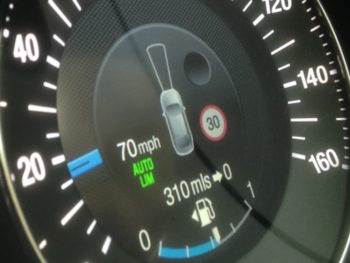All systems go for mandatory new car safety tech
EU Member States have given the green light to new vehicle safety standards that will see features such as AEB and Intelligent Speed Assistance become mandatory on new cars from mid-2022.

The plans will see technology such as overridable ISA required on new vehicles in Europe by mid-2022
The final approval by Member States to the deal agreed in March this year will see the EU press ahead with plans for all motor vehicles (including trucks, buses, vans and sport utility vehicles) to be equipped with safety features, ranging from intelligent speed assistance and the ability to be fitted with alcohol interlock installation facilitation, through to driver drowsiness and attention warning systems, advanced driver distraction warning systems, reversing detection systems and event data recorders.
Cars and vans will be required to have advanced emergency braking systems, emergency lane-keeping systems and enlarged head impact protection zones capable of mitigating injuries in collisions with vulnerable road users, such as pedestrians and cyclists.
And new trucks and buses will be required to have improved levels of ‘direct vision’ to help reduce incidents involving vulnerable road users such as pedestrians and cyclists.
The regulation also enables the Commission to enact specific rules for the safety of hydrogen-powered vehicles and of automated vehicles. More generally, it provides for Commission to update the new specifications to take account of future technical developments.
Timo Harakka, Finnish minister for employment, said: “These new rules will help us to reduce significantly the number of fatalities and severe injuries on EU roads. They also enhance the European car manufacturers’ competitiveness in the global market.”
The new regulation will be applied in the UK too, with the Department for Transport (DfT) having previously said new EU rules that have been provisionally agreed would apply to the UK despite Brexit.
Speaking at the time of the provisional deal in March, Antonio Avenoso, executive director of the European Transport Safety Council (ETSC), said a formal green light would represent another key moment for road safety in Europe, alongside the mandatory introduction of the seat belt and the first EU minimum crash safety standards, agreed in 1998.
According to the UK’s Transport Research Laboratory (TRL), the new laws – which are now subject to formal approval before being implemented across Europe – could save 25,000 lives by 2037. Richard Cuerden, head of TRL’s Academy, said: “The advanced safety measures for new vehicles will provide state-of-the-art protection to all road users. intelligent speed assistance and drowsiness and distraction recognition will support drivers in their ongoing tasks; autonomous emergency braking and emergency lane Keeping will intervene in the most critical situations to avoid a crash; and improved crash tests will ensure that injuries of occupants as well as pedestrians and cyclists are minimised in the remaining collisions.”







